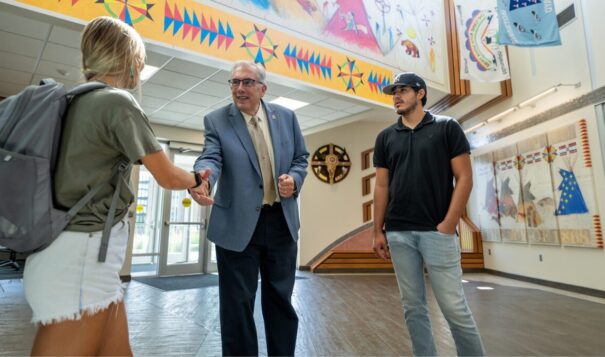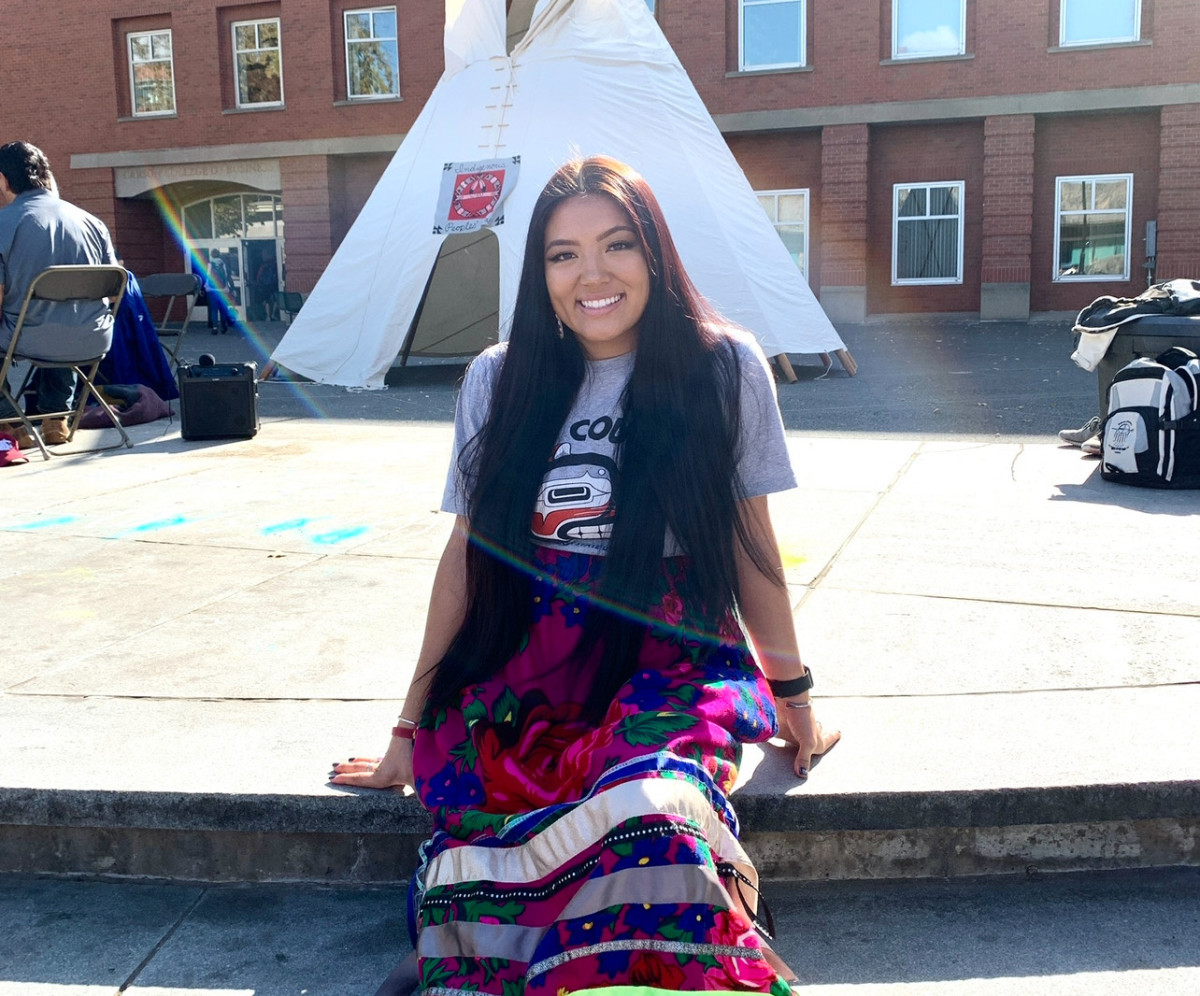News Based on facts, either observed and verified directly by the reporter, or reported and verified from knowledgeable sources.
Beyond acknowledgments, land grant universities make up some impressive ground
 South Dakota State University President Barry Dunn, Rosebud Sioux, confers with two students in the popular SDSU American Indian Student Center, which opened in 2020. (Photo courtesy SDSU)
South Dakota State University President Barry Dunn, Rosebud Sioux, confers with two students in the popular SDSU American Indian Student Center, which opened in 2020. (Photo courtesy SDSU)
College student leaders frustrated with land-grant knowledge gap
Beyond acknowledging the existence of a land-grant university dwelling on historically Indigenous lands, institutions of higher learning seemingly fall short of historical teachings on the subject.
But that doesn’t mean they’re not trying to improve.
A handful of Indigenous students and recent college graduates ICT interviewed expressed frustration with the general lack of knowledge among peers and course curriculum about tribal lands upon which public institutions sit and prosper.
South Dakota State University in Brookings may be considered a case study in typical regional land acknowledgments, while balancing solid programs offered to students. At least nine tribes are represented at the institution.
Indigenous student leader Oakley Jandreau, a senior and a prestigious four-year Wokini Scholar, hails from the Lower Brule Sioux Tribe, or Khulwíčhaša, in South Dakota. From her perspective, hanging out with Indigenous peers makes all the difference.
“Being a Wokini Scholar really enforced community ever since I’ve been here,” she said. “And making sure that all of us Native students had not only a place at the American Indian Student Center to collaborate and be together. We have monthly meetings and we get to see everyone. I think now there’s over a hundred of us. So there’s quite a few of us around campus, which is really nice.”
The scholarship is part of the Wokini Initiative, which SDSU launched in 2016 to ensure land-grant revenue would be more sustainable, on top of grants to support student success. The initiative received more than $600,000 from land-grant revenue to develop Wokini.
But the initiative goes beyond a simple land acknowledgment, outreach, tribal collaboration and striving for academic success. It also explicitly advocates pro-actively embracing land revenue earmarks for such programs, plus leveraging revenue from a portfolio of other gifts and grants to SDSU — specifically to improve American Indian opportunities that support the university’s land-grant mission of access to higher education.
Wokini goals are to improve support systems, boost enrollment and improve graduation rates for Native American students.
“Students definitely are far less aware than faculty are, which, in my opinion, is pretty disappointing,” said Jandreau. “Students coming to school here and paying money to be in these classes should understand those things.”

She seeks more in-depth information and conversations between professors and students. Nevertheless, SDSU remains a leading source, with lectures such as one that combines data sovereignty, artificial intelligence and tribal self-determination.
Founded in 1881 as the state’s first land-grant university, South Dakota State University officially earned that status on July 2, 1862, with the Morrill Act, often characterized as “landmark,” which authorized the federal government to buy up Indigenous lands and designate them as locations for institutions of higher learning. The Morrill Act “was a reaction to a long-simmering dissatisfaction with a higher-education system designed to teach offspring of the wealthy about ancient languages and European literature,” according to an SDSU web page.
The Morrill Act, behind sponsor Justin Smith Morrill, a Vermont congressman, sought to create a system of state universities that would focus on teaching agriculture, mechanics and military tactics without excluding literary or scientific studies, according to the SDSU website. In Montana, that land-grant system today includes Montana State University and seven tribal colleges.
As part of the 1887 Dawes Act, the federal government claimed and assigned 160,000 acres to South Dakota to support its new land-grant college and agricultural experiment station. University president Barry Dunn’s biography page states that “Through providing the annual resources generated by the land, Dunn is returning the benefit to the heirs from whom the land was taken.”
Idealism from the start seems to be the recurring theme among land-grant universities and their ongoing, undeniable ties to the original Indigenous land owners. “Rooted in the land-grant ideals of teaching, research and outreach,” reads the SDSU land grant mission, the acknowledgment further offers “broad access to opportunity and discovery.”
That’s a lot of ground to cover. But Dunn, Rosebud Sioux, said SDSU has succeeded in many programs for Native American students, many of whom come from the following federally recognized Sioux tribes: Cheyenne River, Crow Creek, Flandreau Santee, Lower Brule, Oglala, Rosebud, Sisseton-Wahpeton, Yankton and Standing Rock.
“All those tribes are in South Dakota,” he said. “Standing Rock headquarters are actually in North Dakota, but all of them have a great deal of land in South Dakota. And we’ve sponsored many programs over many decades that have been put in place.”
Among the longtime programs the university sponsors are SNAP benefits, the food and nutrition benefits in collaboration with the tribes through extension services to communities.
“We provide those benefits. I didn’t say we had done it very well. So recently, in the last seven years, we started a program called Wokini in Lakota. That means ‘new beginning.’”
Dunn said SDSU has recommitted to better serving tribal citizen students.
“So that program has been evolving. And to do that, we’ve used the resources that we receive annually from our land-grant land. And so the benefits that we receive from the land grant land are used to benefit the heirs from whom the land was taken.”
Dunn, as a Rosebud Sioux, sees the complexity of the land-grant acquisitions versus the benefits of ancestral lands today.
Providing higher education to all — not only Indigenous students — is one provision of the Morrill Act.
“So we take that very seriously,” said Dunn. “We’re trying to provide the benefits of higher education to all the citizens of South Dakota, including the 9 percent of our state that is American Indian.”
In South Dakota, the Commissioner of School and Public Lands manages the land trust for SDSU, and Dunn said the university receives rental income from the land. He shared an inkling of how the process works.
“If the land had been sold over … a century, then that money was put in trust to benefit South Dakota State [University]. And what we’ve done is taken that annual flow of money, which is more than half a million dollars a year. It varies depending on land rent. We invest that in a tribal recruiter, a recruiter for tribal students, additional advisers and programming. Right now we have an associate vice president, who’s leading the program. And so our resources fund this activity to improve student success here at South Dakota State.”
Jandreau credits SDSU’s American Indian Student Center with providing her crucial support. Conference rooms, a printing center, classroom, kitchen and student pantry, drum room, beading class, equine course, elder-in-residence and artist-in-residence, star talks with elders.
“I love it in there,” Jandreau said. “I’m there every day. It definitely helps create a community for us all.”
Another student told ICT they wish the institution educated all students about the history and significance of land-grant universities — even as Native programs benefit from a variety of financed opportunities that widen representation and inclusion on campus.
Jaissa Grunlose, a 2021 graduate of Washington State University in Pullman, Washington and a citizen of the Colville Confederated Tribes, Entiat, Moses, and Wenatchi bands, secured a vital community job back home in Yakima. She works as the program manager for the Homeowners Assistance Fund Program at Yakama Nation Housing Authority.
For Grunlose, a gap in land-grant information exists among students.
“There is a lot of knowledge between or among myself and our Native peers because we’re always aware that we’re on Native land regardless,” said Grunlose. “We’re always aware, but I think for non-Native students, it’s definitely sometimes a bit of a shock.”

A member of the university’s Native American Women’s Association, Grunlose participated in a land acknowledgment workshop, giving her and her Native college peers important tools to raise awareness about issues affecting Native American women.
“We helped put on the powwow, the round dance, ribbon-making workshops, study tables,” she said. “So it wasn’t just for Native students.”
Grunlose cited strong support from the Native programs at Washington State.
“I always tell everyone that I owe it all to Native programs there at WSU,” she added. “If it wasn’t without the Native American Student Center, I really honestly don’t think I would’ve graduated being at a predominantly white institution. It was super difficult for me being in some classes, being one of the very few people of color. And so it was nice to have the Native student center to come back to and talk to our retention specialists and people like that. So I do give it all to the Native programs there. Staff and everyone was so helpful in helping me succeed at WSU. I think that they’re just really important and they deserve a lot more credit than they get for helping all the students.”
In general, acknowledgments are conversation starters, at the very least.
Another institution, the University of Idaho in Moscow, established in 2007 a Memorandum of Understanding with 11 tribes “surrounding” the institution as a “significant collaboration” and “one of the first in Idaho” to recognize the sovereignty of Idaho tribes.
Land acknowledgment lies at the bottom of the document, signaling that the university sits on the homelands of the Nimiipuu (Nez Perce), Palus (Palouse) and Schitsu’umsh (Coeur d’Alene) tribes.
Even though the school created a council overseeing the unity of the initiative, one section stands out: “promoting a campus climate conducive to cultural competence and meeting the cultural needs of the Native American community at UI.”
Two specific acts included tribal colleges as land-grant institutions: the Equity in Educational Land-Grant Status Act of 1994 and the Federal Agricultural Improvement and Reform Act of 1996.
South Dakota’s tribal colleges include Oglala Lakota College, Sisseton Wahpeton College, Si Tanka/Huron University and Sinte Gleska University, Dunn said, adding that SDSU collaborates with those colleges on grants, accreditations and student transfers to SDSU.
While land grant institutions overall contribute more to Native American programs, Dunn readily admits there’s still much to be done — in retaining Indigenous students, too.
Indigenous students comprise a “fluid” 2 percent of the university’s enrollment. It’s a big step, he said, for students to transition 400 miles from, say, Pine Ridge to the South Dakota State campus.
“It’s hard for young people. So our graduation rate and our retention of freshmen in the past has not been good. It’s been very low and so we’ve worked very hard to improve that. We know we can do better,” he said.
As for Washington State University, the Washington State Department of Natural Resources manages the land held in trust. The Washington State Board of Natural Resources sets policy guidelines, then the Department of Natural Resources administers those trust lands.
A WSU spokesperson said, “While WSU is not permitted to spend investment earnings generated from trust lands on student programs, the university is committed to deepening our connections with Tribal nations and improving support for Native students.” One example is its 2023 priority to create more Native-specific programs.
Washington State University’s land acknowledgment broadly covers 37 tribes located within the state. Zoe Higheagle Strong, Nimiipuu, leads a robust Tribal Relations office.
Jandreau, a Native American Studies and public relations double major, echoes Dunn’s outlook for future improvement in mainstream teachings of what it means to be a land-grant university. She said there’s always work to be done.
“I’ve had Indigenous professors who have [gone] farther in depth on it in the syllabi,” added Jandreau. “I think that that is progression, but if we could have everybody doing that, that would be great.”
